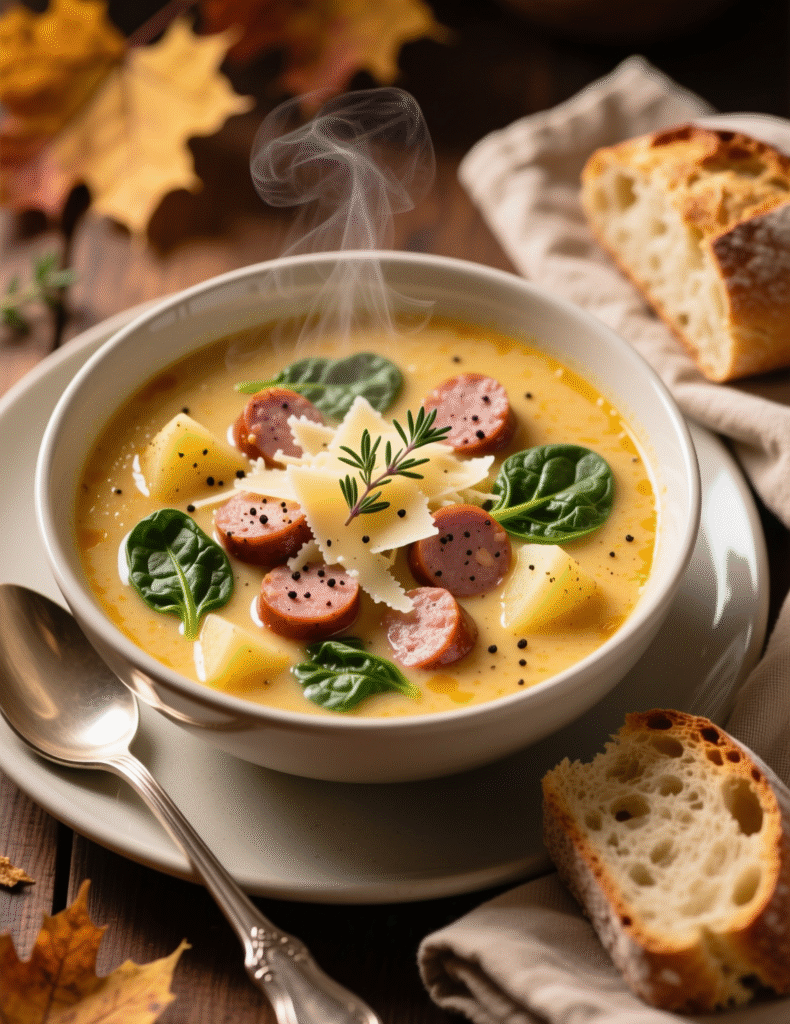When the air turns crisp and the trees shed their gold, something stirs deep inside every cook’s heart—a longing for warmth in a bowl. The Cozy Parmesan Sausage Soup for Fall is exactly that. It’s hearty, rich, and just the right amount of indulgent. The kind of soup that makes you close your eyes for a second after the first spoonful. And it’s not just comfort food—it’s smart cooking. Balanced flavors, protein-packed ingredients, and the sort of aroma that makes the whole house feel like a hug.
Why This Soup Feels Like Fall
Every season has its flavor. Summer is citrus, winter is spice, and fall—it’s the earthiness of sausage, the creaminess of cheese, and the mellow sweetness of simmered vegetables. This soup wraps all of that together. Think of it as the perfect intersection between rustic charm and culinary precision. The Parmesan adds an umami depth that feels almost old-world Italian, while the sausage grounds it in something deeply American and cozy.
What makes this soup shine isn’t complexity. It’s restraint. Every ingredient earns its place in the pot. Nothing extra, nothing loud. Just real, slow, layered comfort.
Ingredients That Matter
Good soup starts with good ingredients. And here, that means quality sausage and real Parmesan, not the kind in a green shaker. Here’s what you’ll need for six generous servings:
- 1 pound Italian sausage (mild or spicy, depending on mood)
- 1 tablespoon olive oil
- 1 large yellow onion, finely chopped
- 3 garlic cloves, minced
- 3 medium carrots, diced
- 2 stalks celery, chopped
- 4 cups chicken broth (low sodium preferred)
- 1 cup heavy cream
- ½ cup grated Parmesan cheese (freshly grated)
- 1 teaspoon dried thyme
- ½ teaspoon crushed red pepper flakes (optional, for a gentle kick)
- 2 cups chopped spinach or kale
- Salt and black pepper, to taste
- Fresh parsley, for garnish
Notice something? No butter, no flour, no roux. The cream and cheese do the thickening, naturally. It’s a clever kind of simplicity that professional chefs appreciate—the kind that relies on technique rather than shortcuts.

Building the Flavor Base
The first ten minutes decide the fate of this soup. That’s when flavor develops. You start with olive oil and sausage in a heavy pot—cast iron or enameled Dutch oven works best. Let the sausage brown, not just cook. You want those caramelized bits sticking to the bottom, the “fond,” as chefs say. That’s pure gold.
Remove the sausage once browned, leaving behind the rendered fat. Add the onions. They’ll pick up the flavor, softening into something sweet and golden. Garlic next, but don’t let it burn—thirty seconds is all it needs. Then in goes the celery and carrots, and that’s when your kitchen starts smelling like fall itself.
The Science Behind the Broth
When you pour in the chicken broth, something magical happens. Those browned bits lift off the pot’s bottom, infusing every drop with depth. That’s called deglazing, and it’s what separates a flat soup from a layered one. Simmering this mixture gently for about 15 minutes lets the vegetables tenderize and meld.
If you’re wondering about stock vs. broth, here’s a quick note. Stock gives body, broth gives flavor. Professionals often use a blend—homemade stock fortified with commercial broth for both depth and clarity.
Reuniting the Cast
Add the browned sausage back into the pot. Let it simmer quietly with the broth and vegetables for another 10 minutes. Now comes the cream—pour it in slowly, stirring as you go. The soup will turn golden and silky.
Then comes Parmesan, freshly grated. Don’t dump it all at once. Stir it in gradually so it melts evenly and doesn’t clump. This is where patience turns to payoff. The cheese thickens the soup slightly and gives it that luxurious mouthfeel that clings to your spoon just a bit.
Toss in the spinach or kale last, just before serving. You want it wilted, not mushy.
Expert Tip: Control the Heat
One of the most common mistakes people make with cream-based soups is overheating. Once the cream is added, the soup should never boil. Gentle simmering only. Boiling causes fat separation, giving your soup an oily top and grainy texture. Professionals know: heat is the quiet architect of flavor and texture alike.
Texture Talk: Getting It Just Right
The texture of a good Parmesan sausage soup should be velvety but substantial. If it feels too thick, splash in a bit more broth. Too thin? Let it simmer uncovered for a few minutes longer. Every pot behaves differently, and that’s part of the charm of homemade soup.
For an extra luxurious finish, some chefs blend half of the soup and return it to the pot. That move gives it body while keeping chunks intact. Totally optional, but worth trying once.
A Note on Sausage
Let’s talk sausage for a moment. The quality here can make or break the dish. Fresh Italian sausage from a butcher will have more depth and less salt than pre-packaged options. If you’re using store-bought, drain the fat carefully—it tends to render more.
Spicy or mild? Depends on what kind of comfort you want. Spicy adds a spark that pairs beautifully with Parmesan, while mild keeps things mellow and classic. Some chefs even mix half and half for balance.
Why Parmesan Is Irreplaceable
Parmesan isn’t just cheese—it’s seasoning. Its umami quality enhances every other ingredient in the pot. You could technically use Pecorino Romano, but it’s saltier and sharper. Real Parmigiano-Reggiano, aged at least 18 months, gives the soup a deep, nutty undertone that mellows the sausage and cream beautifully.
If you’ve ever wondered why restaurant soups taste “rounder” than homemade, it’s often this: they finish with Parmesan rinds simmered into the broth. Don’t throw those away next time.
Nutritional Insight
Now, let’s peek under the hood a bit. Each serving (roughly one and a half cups) comes in around 480–520 calories, depending on the fat in your sausage and cream. You’re getting about 20g of protein, 35g of fat (mostly from sausage and dairy), and 10–12g of carbs from the vegetables.
It’s a rich soup, yes—but nutrient dense. The spinach adds iron and fiber, the carrots bring beta-carotene, and the broth offers collagen if homemade. It’s comfort food that doesn’t feel careless.
Serving Ideas
Pair this soup with crusty sourdough bread, maybe rubbed with a clove of garlic and toasted with olive oil. A sprinkle of fresh parsley or even a drizzle of truffle oil can take it from cozy to restaurant-worthy.
Wine pairing? A medium-bodied Chardonnay works wonders. Its buttery notes complement the cream, while the acidity balances the sausage’s richness. For red lovers, try a Chianti—rustic enough to match the soup’s depth.

Storage and Reheating Tips
This soup actually tastes better the next day. The flavors marry overnight. Store it in an airtight container in the fridge for up to 3 days. When reheating, do it gently on the stove over medium-low heat. Add a splash of broth or cream if it’s thickened too much.
Avoid freezing—it can break the cream and alter the texture. If you must, freeze before adding the dairy and stir the cream and cheese in fresh when reheating.
Common Mistakes to Avoid
- Overcooking the cream. Boiling after adding dairy ruins texture.
- Using pre-grated Parmesan. It clumps and doesn’t melt right.
- Skipping the browning. That’s where flavor begins.
- Not seasoning in layers. Add salt gradually—sausage and Parmesan both bring their own.
Emerging Trend: Elevated Comfort Food
There’s a quiet trend in professional kitchens right now—comfort food done elegantly. Chefs are rediscovering the emotional power of simple dishes, refining them with better ingredients and technique. This soup fits right into that movement. It’s rustic but composed, familiar yet refined.
More restaurants are embracing “farm-to-bowl” soups—using local sausage, fresh cream, and artisan cheese. What used to be humble is now artful.
Professional Chef’s Insight
In restaurant kitchens, soups like this are the silent heroes. They use up scraps of vegetables, ends of cheese, leftover broth. But the trick is precision—cut size, timing, layering of heat. That’s what separates “homemade” from “professionally executed.”
Even at home, you can apply the same principles. Keep your knife cuts uniform so everything cooks evenly. Taste constantly. Adjust acidity, salt, and fat balance as you go. A squeeze of lemon before serving can wake everything up, believe it or not.
The Emotional Side of Soup
Cooking this soup is more than following a recipe. It’s an act of grounding. When the world outside feels too loud, there’s something steady about stirring a simmering pot. The smell of garlic, the slow swirl of cream—it’s almost meditative.
And when you ladle it out, watch how people react. Shoulders drop. Conversations slow. That’s the quiet power of a good soup—it doesn’t just feed you, it steadies you.
Final Thoughts
The Cozy Parmesan Sausage Soup for Fall isn’t a meal, it’s a moment. A bowl of balance—between rich and light, rustic and refined, old and new. Whether you’re a home cook or a professional chef, it’s a reminder that mastery doesn’t come from complication. It comes from care.
So, grab your pot. Brown that sausage. Let the onions do their slow dance. Taste as you go. And when it’s done, take that first spoonful slowly—you’ve earned it.
FAQs
What type of sausage works best for this Parmesan Sausage Soup?
Italian sausage, either mild or spicy, gives the best balance of flavor and richness for this soup.
Can I substitute the heavy cream with something lighter?
Yes, you can use half-and-half or evaporated milk, though the texture will be slightly less creamy.
What kind of Parmesan should I use?
Always use freshly grated Parmigiano-Reggiano for the best melt and depth of flavor.
Can this soup be made ahead of time?
Absolutely, it tastes even better the next day as the flavors meld together overnight.
Is it okay to freeze the soup?
It’s best not to freeze after adding cream—freeze before adding dairy and mix it in when reheating.
How long can I store the soup in the refrigerator?
Store it in an airtight container for up to 3 days for best quality and taste.
How do I prevent the soup from curdling?
Avoid boiling after adding cream—keep it on a gentle simmer instead.
What’s the best side to serve with this soup?
Crusty sourdough bread or garlic toast pairs perfectly with this creamy, savory soup.
Can I make this recipe vegetarian?
Yes, swap the sausage for plant-based sausage and use vegetable broth instead of chicken broth.
How many servings does this recipe make?
The recipe makes about six hearty servings, ideal for family dinners or meal prep.

Marie Smith is a passionate recipe blogger, sharing easy, delicious, and creative culinary ideas that inspire home cooks to elevate everyday meals with flavor and simplicity.
